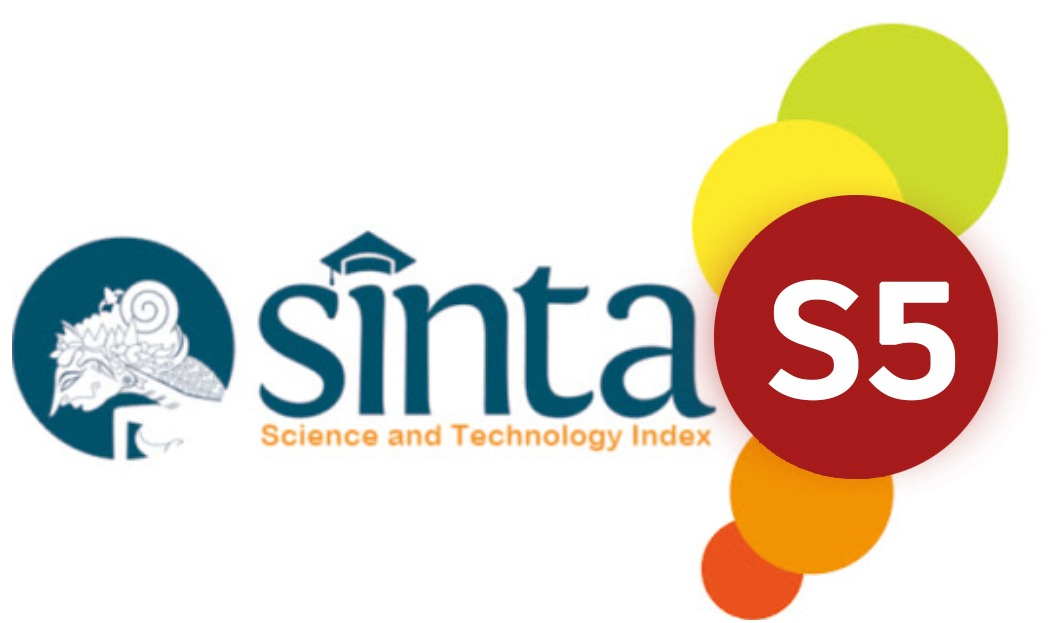INDONESIAN LANGUAGE LEARNING FOR NON-NATIVE SPEAKERS THROUGH ONLINE MUSIC AND LEARNER ASSESSMENT
Abstract
Keywords
References
Anggrarini, N., & Faturokhman, I. (2021). Students' perception on the use of youtube in English language learning during pandemic in Wiralodra University. Journal of English Language and Language Teaching (JELLT), 5(1), 86-99. doi: 10.36597/jellt.v5i1.10029
Antika, R. (2021). The effects of English songs in learning vocabulary for young learners. The 10th National Online Seminar on Linguitics, Language Teaching and Literature, 10(1), 119-131. doi: 10.32493/.v10i1.9321
Besedova, P. (2016). Music as an intercultural medium of foreign language teaching. In Z. Bekirogullari, M. Y. Minas, & R. X. Hambusamy (Eds.), The European Proceedings of Social & Behavioural Sciences EpSBS (pp. 646-662). doi: 10.15405/epsbs.2016.11.68
Busse, V., Hennies, C., Kreutz, G., & Roden, I. (2021). Learning grammar through singing? An intervention with EFL primary school learners. Learning and Instruction, 71 (June 2019), 101372. doi: 10.1016/j.learninstruc.2020.101372
Busse, V., Jungclaus, J., Roden, I., Russo, F. A., & Kreutz, G. (2018). Combining song- and speech-based language teaching: An intervention with recently migrated children. Frontiers in Psychology, 9(NOV), 1-10. doi: 10.3389/fpsyg.2018.02386
Cahyana, A. A. C. (2020). The use of Youtube video in teaching English for foreign language at vocational high school. Journal of Indonesian English Education, 8(2), 1-11. doi: 10.23887/jpbi.v8i2.3399
Chiriac, L. (2015). If You Like Music, You Can "Play" Grammar. Procedia - Social and Behavioral Sciences, 197(June), 826-833. doi: 10.1016/j.sbspro.2015.07.204
Cores-Bilbao, E., Fernández-Corbacho, A., Machancoses, F. H., & Fonseca-Mora, M. C. (2019). A music-mediated language learning experience: Students' awareness of their socio-emotional skills. Frontiers in Psychology, 10(October), 1-10. doi: 10.3389/fpsyg.2019.02238
Defina. (2021). BIPA students' assessment of face-to-face and online learning. Journal of Indonesian Language for Foreign Speakers (JBIPA), 3(1), 12-23. doi: 10.26499/jbipa.v3i1.3482
Defina, & Rizkillah, R. (2021). Problems, stress, social support, and coping strategies during the Covid-19 Pandemic: Case of international college students in Indonesia. Journal of Family and Consumer Sciences, 14(3), 282-295. doi: 10.24156/jikk.2021.14.3.282
Degrave, P. (2019). Music in the foreign language classroom: How and why? Journal of Language Teaching and Research, 10(3), 412-420. doi: 10.17507/jltr.1003.02
Diani, W. R., & Dewi, L. S. (2020). The challenges of BIPA teachers facing online learning during the Covid-19 pandemic. Transformatics: Journal of Language, Literature, and Teaching, 4(2), 1-15. doi: 10.31002/transformatika.v%vi%i.3179
Editia, H. (2019). The challenge of learning bipa with synchronous interaction e-learning method using online language learning application. In S. Arimi, W. Kurniawati, S. Anwar, & A. Mashlihatin (Eds.), International Conference on teaching Indonesian for foreign speakers (KIPBIPA) (pp. 430-441). Retrieved from http://kipbipa.appbipa.or.id/unduh/prosiding_kipbipa11/22 Editia.pdf
Fauziah, W. N., Supendi, D. A., & Humaira, H. W. (2018). The use of Indonesian language learning methods for foreign speakers. Belajar Bahasa, 3(2), 230-243. doi: 10.32528/bb.v3i2.1592
Hasan, H. (2016). Music media (songs) in Arabic language learning at MI level. Al Qalam: Scientific Journal of Religion and Society, 9(17), 55-74. doi: 10.35931/aq.v0i0.53
Ilmi, A. F. (2020). Singing media in mastering new Arabic vocabulary in low grade students of Madrasah Ibtidayah. Al-Falah: Scientific Journal of Islamic and ..., 20(1), 79-101. Retrieved from http://ejurnal.staialfalahbjb.ac.id/index.php/alfalahjikk/article/view/139%0Ahttps://ejurnal.staialfalahbjb.ac.id/index.php/alfalahjikk/article/download/139/150
Israel, H. F. (2013). Language learning enhanced by music and song. Literacy Information and Computer Education Journal, Special 2(1), 1360-1366. doi: 10.20533/licej.2040.2589.2013.0180
Kara, Z. E., & Aksel, A. S. (2013). The Effectiveness of music in grammar teaching on the motivation and success of the students at preparatory school at Uludağ University. Procedia - Social and Behavioral Sciences, 106, 2739-2745. doi: 10.1016/j.sbspro.2013.12.314
Keskin, F. (2011). Using songs as audio materials in teaching Turkish as a foreign language. Turkish Online Journal of Educational Technology, 10(4), 378-383.
Lee, L., & Lin, S.-C. (2015). The impact of music activities on foreign language, English learning for young children. Journal of the European Teacher Education Network, 10, 13-23.
Ludke, K. M. (2009). Teaching Foreign Languages through Songs. Edinburgh: Institute for Music in Human and Social Development (IMHSD).
Meilawati, A. (2019). Songs as a Medium of Language Mastery and Cultural Introduction in BIPA Learning in QJNU China. In S. Arimi, W. Kurniawati, S. Anwar, & A. Mashlihatin (Eds.), International Conference on Indonesian Language Teaching for Foreign Speakers (KIPBIPA) XI (pp. 633-648). Yogyakarta: Affiliation of Indonesian Language Teachers and Activists for Foreign Speakers (APPBIPA) in collaboration with Indonesian Language and Culture Learning Service (INCULS).
Millington, N. T. (2011). Using Songs Effectively to Teach English to Young Learners. Language Education in Asia, 2(1), 134-141. doi: 10.5746/leia/11/v2/i1/a11/millington
Miranti, I., Engliana, & Hapsari, F. S. (2015). The use of nursery rhyme media in developing students' English vocabulary skills in PAUD. Scientific Journal of Education, 2(2), 167-173. Retrieved from https://journal.lppmunindra.ac.id/index.php/Faktor/article/viewFile/382/364
Mulyaningsih, I. (2017). Indonesian Language Learning for Foreign Speakers in Cirebon. International Symposium: Indonesian Language Teaching for Foreign Speakers (BIPA), 420-425. Retrieved from https://bipa.kemdikbud.go.id/filebakti/403Kumpulan_Esai_SIPBIPA_2017.pdf
Nofrika, I. (2019). EFL students' voices: The role of Youtube in developing English competencies. Journal of Foreign Languange Teaching and Learning, 4(1), 57-73. doi: 10.18196/ftl.4138
Odo, D. M. (2021). Examining the influence of English songs on English L2 lexical learning: a quantitative meta-analytic review. Language, Culture and Curriculum, (December), 1-18. doi: 10.1080/07908318.2021.2022684
Poniman. (2017). Engineering the transfer of English materials into songs to spur students' interest in learning. Indonesian Journal of Primary Education, 1(1), 41-50. doi: doi.org/10.17509/ijpe.v1i1
Purwanti, R. (2020). English learning for early childhood through movement and song methods. Potensia Scientific Journal, 5(2), 91-105. Retrieved from https://ejournal.unib.ac.id/index.php/potensia/article/view/10956/6194
Rasman. (2021). The use of Youtube as a medium for learning English during the Covid 19 pandemic. EDUTECH: Journal of Technology-Assisted Education Innovation, 1(2), 118-126. doi: 10.51878/edutech.v1i2.442
Ridwan, R., & Awaluddin, A. F. (2019). The application of singing method in improving the mastery of mufradat in Arabic language learning in Raodhatul Athfal. DIDAKTIKA: Journal of Education, 13(1), 56-67. doi: 10.30863/didaktika.v13i1.252
Rukholm, V. N. (2015). Singing to speak: An examination of adult L2 learners and vocabulary learning through song. Italica, 92(1), 171-192. Retrieved from http://www.jstor.org/stable/43895229
Rusmanayanti, A. (2019). Songs from Youtube as an alternative media innovation for teaching and learning English. Getsempena English Education Journal (GEEJ), 6(1), 143-155. doi: 10.46244/geej.v6i1.862
Salcedo, C. S. (2010). The effects of songs in the foreign language classroom on text recall, delayed text recall and involuntary mental rehearsal. Journal of College Teaching & Learning (TLC), 7(6), 19-30. doi: 10.19030/tlc.v7i6.126
Sarifuddin, M., & Kurniawati, I. (2018). The effect of English song lyrics in teaching vocabulary towards students' listening comprehension at the third grade students of SMPN 3 Gunungsari in academic year 2017/2018. Scientific Journal of Mandala Education, 4(1), 325. doi: 10.36312/jime.v4i1.556
Septianasari, L. T. (2021). Indonesian Language Training for Foreign Speakers through an online platform. Jurnal Masyarakat Mandiri, 5(2), 345-353. doi: 10.31764/jmm.v5i2.4020
Sihvola, L. H., & Gafor, S. (2020). The effectiveness of using songs and music to foster motivation and language development in the young (Malmo Universitet). Retrieved from http://www.diva-portal.org/smash/record.jsf?pid=diva2%3A1492310&dswid=1104
Tawandorloh, K.-A., Islahuddin, I., & Nugraheny, D. C. (2021). Indonesian Language Program for Foreign Speakers (BIPA) at Fatoni University, Thailand. Indonesian Language Education and Literature, 7(1), 139-151. doi: 10.24235/ileal.v7i1.8603
Tayari, F. A., & Zafarghand, A. M. (2015). The effect of english verbal songs on connected Speech aspects of adult English learners' speech production. Advances in Language and Literary Studies, 6(1), 212-225. doi: 10.7575/aiac.alls.v.6n.1p.212
Tyasrinestu, F. (2019). Environmental Themes in Indonesian Children's Songs as Media for Beginner BIPA Learning. In S. Arimi, W. Kurniawati, S. Anwar, & A. Mashlihatin (Eds.), International Conference on Indonesian Language Teaching for Foreign Speakers (KIPBIPA) XI (pp. 583-590). Yogyakarta: Affiliation of Indonesian Language Teachers and Activists for Foreign Speakers (APPBIPA) in collaboration with Indonesian Language and Culture Learning Service (INCULS).
Werner, V. (2020). "Song-advantage" or "Cost of Singing"? A Research Synthesis of Classroom-based Intervention Studies Applying Lyrics-based Language Teaching (1972-2019). Journal of Second Language Teaching & Research, 8, 138-170. Retrieved from https://fis.uni-bamberg.de/handle/uniba/49313
Zeromskaite, I. (2014). The potential role of music in second language learning: A review article. Journal of European Psychology Students, 5(3), 78-88. doi: 10.5334/jeps.ci
DOI: 10.33751/jsalaka.v7i1.12713
Refbacks
- There are currently no refbacks.

This work is licensed under a Creative Commons Attribution-ShareAlike 4.0 International License.






